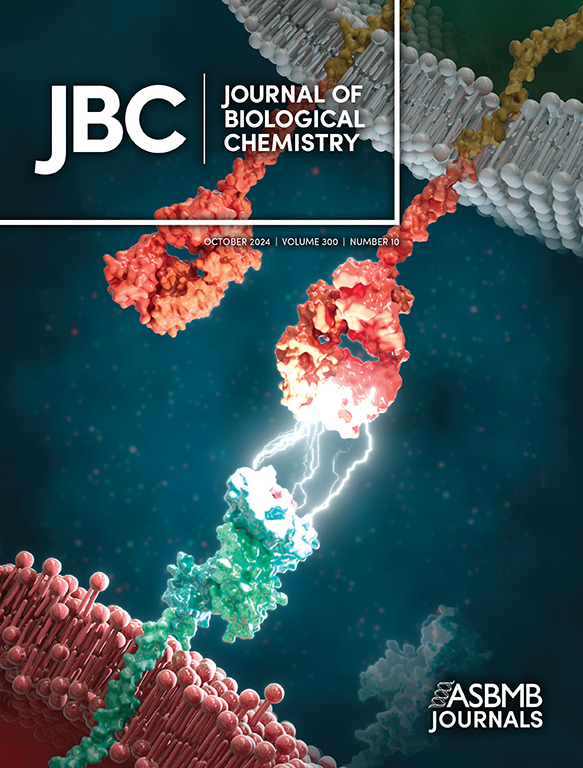氯法齐明作为治疗霍乱的抗生素:细胞和结构靶点的鉴定。
IF 4
2区 生物学
Q2 BIOCHEMISTRY & MOLECULAR BIOLOGY
引用次数: 0
摘要
霍乱弧菌通过至少七次大流行浪潮塑造了人类文明的面貌。当前的浪潮显示出多药耐药性,造成了巨大的人员和经济损失,以及人道主义危机,并有可能使整个国家的卫生保健系统崩溃。这种和其他病原体的抗生素耐药性是一个紧迫的威胁,由于开发新抗生素的成本高昂,仍然没有得到解决。在这项工作中,我们测试了几种fda批准的非那嗪类药物和吩噻嗪类药物,并确定氯法齐明(Lamprene)在培养和体外感染模型中对霍乱弧菌细胞显示出很强的抗生素作用,其浓度远低于临床使用的人体剂量。我们的研究结果表明,在动物模型中,氯法齐明在治疗霍乱方面与氨苄西林一样有效。此外,氯法齐明显示出很强的抗毒特性,几乎完全抑制霍乱毒素的产生。通过对霍乱弧菌代谢的表征,我们确定氯法齐明在该病原体中的主要靶点是呼吸复合体NQR,这是一种在能量代谢、毒力因子产生和多药耐药中起关键作用的必需酶,广泛分布于致病菌中。生化和计算分析表明,氯法齐明的结构靶点是催化活性泛素结合位点,这是一种独特的结构基元,在任何人类蛋白质中都没有发现,使其成为理想的药理学靶点。这些结果表明氯法齐明可用于治疗霍乱,并为开发一类针对NQR的新型抗生素提供了机会。本文章由计算机程序翻译,如有差异,请以英文原文为准。
Repurposing clofazimine as an antibiotic to treat cholera: Identification of cellular and structural targets.
Vibrio cholerae has shaped the face of human civilization through at least seven pandemic waves. The current wave shows multidrug resistance, has produced enormous human and economic losses, as well as humanitarian crises, and has the potential to collapse the healthcare system of entire countries. Antibiotic resistance in this and other pathogens is an urgent threat that remains unaddressed due to the significant costs to develop new antibiotics. In this work, we have tested several FDA-approved phenazines and phenothiazines, and have identified that clofazimine (Lamprene) shows strong antibiotic effects against V. cholerae cells in culture and in an in vitro infection model, at concentrations well below the clinically-used doses in humans. Our results show that in an animal model, clofazimine is as effective as ampicillin in the treatment of cholerae. In addition, clofazimine shows strong antivirulence properties, almost completely inhibiting cholera toxin production. The characterization of V. cholerae metabolism allowed us to identify that clofazimine's main target in this pathogen is the respiratory complex NQR, an essential enzyme that plays a crucial role in energy metabolism, virulence factor production and multidrug resistance, which is widely distributed among pathogenic bacteria. Biochemical and computational analyses show that the structural target of clofazimine is the catalytically-active ubiquinone-binding site, which is a unique structural motif, not found in any human protein, making it an ideal pharmacologic target. These results show that clofazimine can be repurposed to treat cholera, and open opportunities to develop a novel class of antibiotics that target NQR.
求助全文
通过发布文献求助,成功后即可免费获取论文全文。
去求助
来源期刊

Journal of Biological Chemistry
Biochemistry, Genetics and Molecular Biology-Biochemistry
自引率
4.20%
发文量
1233
期刊介绍:
The Journal of Biological Chemistry welcomes high-quality science that seeks to elucidate the molecular and cellular basis of biological processes. Papers published in JBC can therefore fall under the umbrellas of not only biological chemistry, chemical biology, or biochemistry, but also allied disciplines such as biophysics, systems biology, RNA biology, immunology, microbiology, neurobiology, epigenetics, computational biology, ’omics, and many more. The outcome of our focus on papers that contribute novel and important mechanistic insights, rather than on a particular topic area, is that JBC is truly a melting pot for scientists across disciplines. In addition, JBC welcomes papers that describe methods that will help scientists push their biochemical inquiries forward and resources that will be of use to the research community.
 求助内容:
求助内容: 应助结果提醒方式:
应助结果提醒方式:


